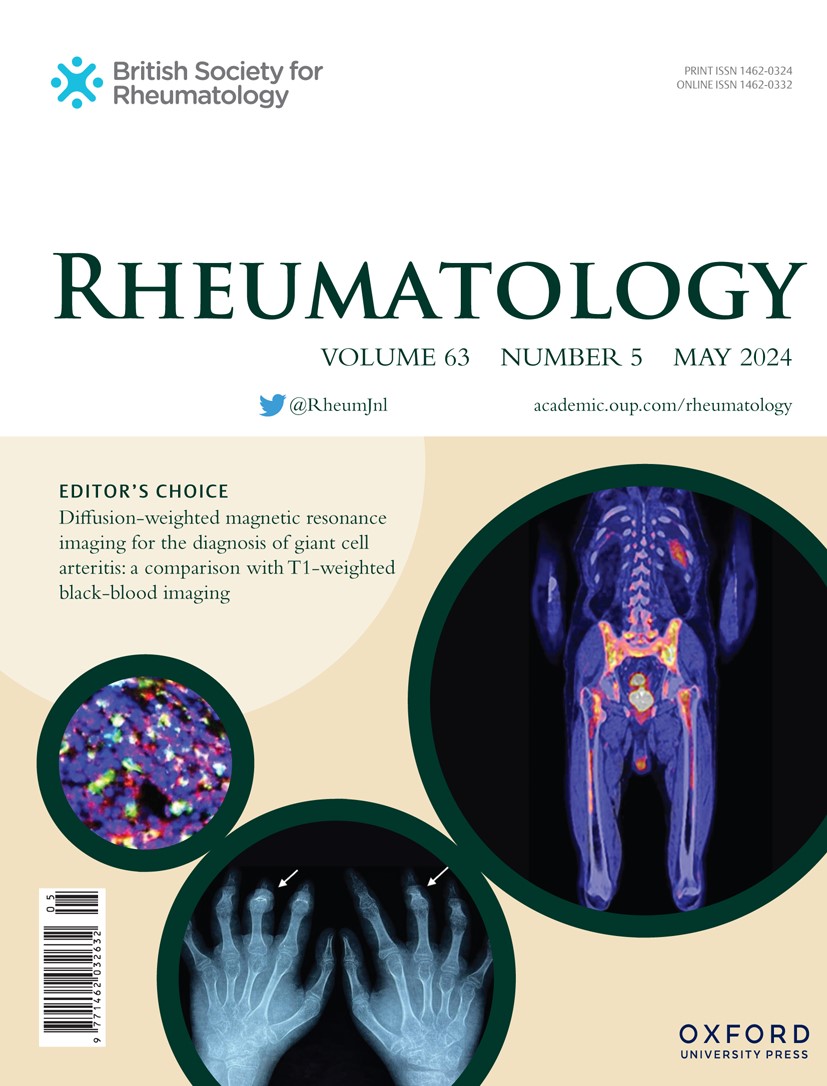巴西替尼治疗难治性或重度青少年皮肌炎的长期有效性和安全性
IF 4.7
2区 医学
Q1 RHEUMATOLOGY
引用次数: 0
摘要
本研究的目的是评估baricitinib (BAR)附加治疗难治性或重度青少年皮肌炎(rsJDM)的长期有效性和安全性。方法在本单中心回顾性研究中,27例rsJDM患儿对皮质类固醇(CS)和免疫抑制剂反应不佳,采用BAR治疗。疾病活动性通过医生总体疾病活动性评估(PhyGloVAS)、儿童肌炎评估量表(CMAS)、手工肌肉测试-8 (MMT-8)和疾病活动性评分(DAS)进行评估。在BAR治疗开始后的0、6、12、24和36个月,根据PRINTO标准确定疾病反应。结果在平均25.1个月(12 - 58个月)的随访期间,77%的患者(27名患者中的21名)皮疹得到改善,62%的患者皮疹完全消退。中位值分析显示,12个月时皮肤DAS显著下降(6.0 vs 0.8, p<;0.01)。此外,CMAS评分在12个月时显著升高(40.5 [30.8,45.0]vs 52.0[50.0, 52.0])。MMT-8评分在12个月时也显著升高(66.0 [47.8,72.3]vs 79.0 [79.0, 80.0], p= 0.004)。3例无应答患者的最后一次观察延续12个月的数据。在36个月的随访过程中,共有70%的患者(27名患者中的19名)达到了非活动性疾病(ID), CS剂量从基线(0.50 [0.34,0.89]mg/kg/d)减少到36个月(p<;0.001)。三分之一的患者(27人中有9人)停止了CS治疗。在6个月、12个月、24个月和36个月的观察点上,患者达到ID的比例分别为48.1%(13/27)、70.8%(17/24)、90.0%(18/20)和92.3%(12/13)。影像学分析显示,一名患者钙质沉着症得到改善,另外两名患者病情稳定。3例间质性肺病患者病情好转,另外3例病情稳定。2例患者巨噬细胞激活综合征得到缓解。1例患者因带状疱疹病毒感染需要住院并暂时停止BAR。没有人因不良事件而死亡或必须永久停用巴西替尼。通过36个月的随访,我们证明了BAR治疗rsJDM患者的总体长期有效性和安全性。本文章由计算机程序翻译,如有差异,请以英文原文为准。
Long-term effectiveness and safety of baricitinib treatment on refractory or severe juvenile dermatomyositis
Objective The objective of this study was to evaluate the long-term effectiveness and safety of baricitinib (BAR) add-on therapy for refractory or severe juvenile dermatomyositis (rsJDM) in a practical, real-world setting. Methods In this single-centre retrospective study, 27 children with rsJDM and poor response to corticosteroids (CS) and immunosuppressants were treated with BAR. Disease activity was assessed via physician global assessment of overall disease activity (PhyGloVAS), the childhood myositis assessment scale (CMAS), manual muscle testing-8 (MMT-8), and the disease activity score (DAS). Disease response was determined according to the PRINTO criteria at 0, 6, 12, 24, and 36 months after the initiation of BAR treatment. Results Over an average follow-up period of 25.1 months (ranging from 12 to 58 months), 77% of patients (21 out of 27) experienced improvement in skin rashes, with complete resolution in 62% of patients. Analysis of the median values revealed a significant decrease in the DAS of the skin at 12 months (6.0 vs 0.8, p< 0.01). Furthermore, the CMAS score significantly increased at 12 months (40.5 [30.8, 45.0] vs 52.0 [50.0, 52.0], p< 0.05), and the MMT-8 score also notably increased at 12 months (66.0 [47.8, 72.3] vs 79.0 [79.0, 80.0], p= 0.004) Last observation for the three patients who did not respond was carried forward for their month 12 data. Over the course of the 36-month follow-up, a total of 70% of patients (19 out of 27) achieved inactive disease inactive disease (ID), with a reduction in CS dosage from baseline (0.50 [0.34, 0.89] mg/kg/d) to (0 [0, 0.10] mg/kg/d) at 36 months (p< 0.001). One-third of patients (9 out of 27) discontinued CS treatment. The percentage of patients who achieved ID was 48.1% (13/27), 70.8% (17/24), 90.0% (18/20), and 92.3% (12/13) at the 6-, 12-, 24-, and 36-month observation points, respectively. Radiographic analysis revealed an improvement in calcinosis in one patient, while stabilization was observed in two others. Interstitial lung disease improved in three patients and stabilized in three others. Macrophage activation syndrome was resolved in two patients. One patient required hospitalization and temporary cessation of BAR due to herpes zoster virus infection. There were no deaths or anyone who had to permanently discontinue baricitinib due to an adverse event. Conclusions We demonstrated the general long-term effectiveness and safety of BAR treatment in patients with rsJDM over a follow-up period of 36 months.
求助全文
通过发布文献求助,成功后即可免费获取论文全文。
去求助
来源期刊

Rheumatology
医学-风湿病学
CiteScore
9.40
自引率
7.30%
发文量
1091
审稿时长
2 months
期刊介绍:
Rheumatology strives to support research and discovery by publishing the highest quality original scientific papers with a focus on basic, clinical and translational research. The journal’s subject areas cover a wide range of paediatric and adult rheumatological conditions from an international perspective. It is an official journal of the British Society for Rheumatology, published by Oxford University Press.
Rheumatology publishes original articles, reviews, editorials, guidelines, concise reports, meta-analyses, original case reports, clinical vignettes, letters and matters arising from published material. The journal takes pride in serving the global rheumatology community, with a focus on high societal impact in the form of podcasts, videos and extended social media presence, and utilizing metrics such as Altmetric. Keep up to date by following the journal on Twitter @RheumJnl.
 求助内容:
求助内容: 应助结果提醒方式:
应助结果提醒方式:


